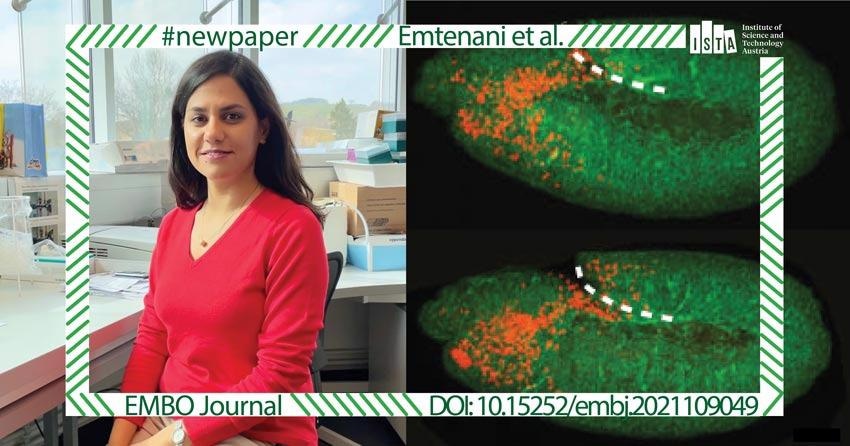Reviewed by Danielle Ellis, B.Sc.Mar 24 2022
Immune cells are the bodies’ cops, but how can they get to the crime scene quickly? Researchers from the Institute of Science and Technology Austria (ISTA) have found a novel protein that stimulates energy generation inside immune cells, allowing them to penetrate more effectively.
 Cell biologist Shamsi Emtenani. Lead author Emtenani described the master regulator Atossa for the first time, proving the mechanism by which it boosts intracellular energy production. Image Credit: © Mariana Guarda/Institute of Science and Technology Austria
Cell biologist Shamsi Emtenani. Lead author Emtenani described the master regulator Atossa for the first time, proving the mechanism by which it boosts intracellular energy production. Image Credit: © Mariana Guarda/Institute of Science and Technology Austria
The findings, which were published in The EMBO Journal, could alter the understanding of energy management in cells across the human body, in addition to enhancing immune responses.
Life must adapt to difficulties to live, particularly through changing the activity of its immune system. Outside infectious pathogens are always attempting to get a foothold within the body, like Covid. However, how can immune cells discover and eradicate pathogens in new tissues?
Professor Daria Siekhaus and Dr Shamsi Emtenani from the ISTA group ended up addressing an even broader question by looking into this critical process: what determines the energy required for cell invasion?
They found a two-step process that enhances energy generation inside immune cells, allowing them to invade tissues with more vigor. This unique pathway is controlled by Atossa, a previously unknown protein named for a Persian queen. While the trials were carried out on fruit flies, the findings suggest that homologous proteins in mammals serve the same purpose.
There is a plethora of potential for how this work can lead to new perspectives of human physiology, because boosting energy production is essential in so many cells throughout the human body.”
Dr Shamsi Emtenani, Study Lead Author, Institute of Science and Technology Austria
Their study with the University of Albany, University of Toronto, CeMM Research Center, and Vienna BioCenter has been published in the European Molecular Biology Organization’s publication (EMBO).
Atossa, ruling to boost energy
It takes a lot of energy for cells to push their surroundings out of the way and move into tissues. The immune system uses mitochondria, the cell’s intrinsic powerhouse, to boost energy levels. Mitochondria convert sugar and other substances into ATP, the cellular currency of energy. Scientists have observed that one protein, Atossa, orchestrates a cascade that controls and enhances mitochondrial energy production capacity.
Atossa acts as both an accelerator pedal and a gear shift. First, the protein activates two metabolic enzymes that help send more fuel into the mitochondrial factory, and second, it shifts the mitochondria into a higher gear.”
Daria Siekhaus, Professor, Institute of Science and Technology Austria
The protein Porthos, an RNA helicase identified after one of the three musketeers noted for their fidelity in serving their queen is increased by Atossa, causing a gear shift. Porthos then assists in the building of the machinery that facilitates protein creation via translation, including many that increase mitochondrial activity and consequently energy generation.
Pioneering fly work relevant for human health
The scientists were able to see a clear reduction in cell migration in the absence of Atossa using live imaging of fruit fly embryos. Furthermore, Atossa’s role is only required in pioneer cells. The first cells, similar to an excursion through a thicket, do the hard job of cutting away with the machete and so require more energy.
The ISTA scientists tested energy levels with and without the Atossa gene, with the help of partner Dr Thomas Köcher from the Vienna BioCenter, and found that Atossa does actually improve them.
A master regulator like Atossa, on the other hand, is found in more than just fruit flies. In flies, the relevant protein coding is 44% identical to that in humans. Indeed, the scientists showed that human genes can take the place of the fruit fly protein’s function.
We are very intrigued by the possibilities this opens up. Atossa could be of key importance for upregulating energy production. In immune cells, this is relevant for example in antibody production and the specification of white blood cells. Atossa-like proteins are also found in brain cells. Here, defects have been shown to underlie neurodegenerative diseases.”
Daria Siekhaus, Professor, Institute of Science and Technology Austria
The legacy of an Iranian woman
“Fly work is the premiere place to nail down complicated genetic mechanisms and identify new things. It takes enormous courage and great cleverness to analyze something completely unexplored. To me, Shamsi’s work, proving every step of the cascade, is an example of the best science you can do in this field,” Siekhaus praises the Iranian, who has joined her laboratory in 2015.
Shamsi Emtenani comments, “I looked at this specific gene out of curiosity. The exciting thing is: If you are the first one that discovers a gene’s function in the fruit fly field, you get the chance to name its protein.”
Emtenani renamed the protein Atossa after it was previously indexed as CG9005. She picked the name of a Persian queen from the Achaemenid Empire because the pioneer cells travel in a line, one by one, much like a water stream.
“Atossa literally means ‘trickling’ and it connects to my background. It seemed fitting as well for a queen who commands three proteins—one of them a musketeer—responsible for making cells invade new territories,” Emtenani concludes.
Source:
Journal reference:
Emtenani, S., et al. (2022) Macrophage mitochondrial bioenergetics and tissue invasion are boosted by an Atossa-Porthos axis in Drosophila. The EMBO Journal. doi.org/10.15252/embj.2021109049.